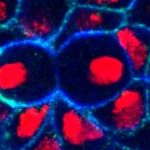Lien vers Pubmed [PMID] – 20671200
Lien DOI – 10.1073/pnas.1002876107
Proc Natl Acad Sci U S A 2010 Aug; 107(33): 14615-20
Cell fate determination depends in part on the establishment of specific transcriptional programs of gene expression. These programs result from the interpretation of the genomic cis-regulatory information by sequence-specific factors. Decoding this information in sequenced genomes is an important issue. Here, we developed statistical analysis tools to computationally identify the cis-regulatory elements that control gene expression in a set of coregulated genes. Starting with a small number of validated and/or predicted cis-regulatory modules (CRMs) in a reference species as a training set, but with no a priori knowledge of the factors acting in trans, we computationally predicted transcription factor binding sites (TFBSs) and genomic CRMs underlying coregulation. This method was applied to the gene expression program active in Drosophila melanogaster sensory organ precursor cells (SOPs), a specific type of neural progenitor cells. Mutational analysis showed that four, including one newly characterized, out of the five top-ranked families of predicted TFBSs were required for SOP-specific gene expression. Additionaly, 19 out of the 29 top-ranked predicted CRMs directed gene expression in neural progenitor cells, i.e., SOPs or larval brain neuroblasts, with a notable fraction active in SOPs (11/29). We further identified the lola gene as the target of two SOP-specific CRMs and found that the lola gene contributed to SOP specification. The statistics and phylogeny-based tools described here can be more generally applied to identify the cis-regulatory elements of specific gene regulatory networks in any family of related species with sequenced genomes.



